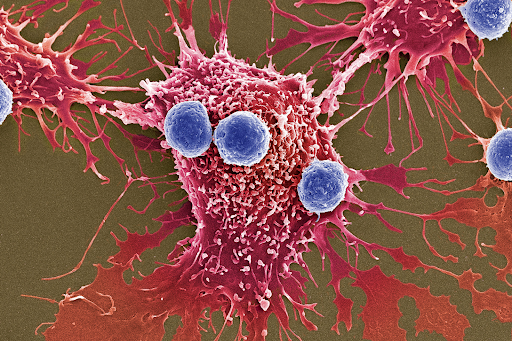
Introduction: Concept and Aetiology.
Cancer of the lungs is a complex and possibly deadly sickness described by the uncontrolled development of unusual cells in the lung tissues. It is a leading cause of cancer-related death and one of the most common kinds of cancer worldwide. Lung cancer’s causes, types, symptoms, diagnosis, treatment options, and strategies for prevention are all the focus of this note.
Types of Lung Cancer:
Lung cancer is extensively categorized into two fundamental types: Lung cancer of the non-small cell (NSCLC) and small cell lung cancer (SCLC). NSCLC represents around 85% of all cancer of the lung cases and is additionally separated into three subtypes: squamous cell carcinoma, large cell carcinoma, and adenocarcinoma. A more aggressive form of lung cancer known as SCLC is characterized by rapid growth and accounts for approximately 10-15 percent of cases.
Symptoms and Diagnosis:
The early stages of lung cancer often exhibit no noticeable symptoms, making detecting the disease in its initial phases challenging. As cancer progresses, common symptoms may include persistent coughing, chest pain, shortness of breath, hoarseness, coughing up blood, unexplained weight loss, fatigue, and recurring respiratory infections. If lung cancer is suspected, various diagnostic tests such as imaging scans (X-rays, CT scans, MRI), sputum cytology, bronchoscopy, and biopsy may be performed to confirm the diagnosis and determine the cancer stage.
Treatment Options:
The treatment approach for lung cancer depends on several elements of concern, including the type and stage of cancer, the overall health of the patient, and personal preferences. The primary treatment modalities include surgery, radiation therapy, chemotherapy, targeted therapy, and immunotherapy. In early-stage lung cancer, surgical tumor removal may be the primary option. Radiation therapy uses high-energetic rays to kill cancer cells, while chemotherapy uses drugs to destroy cancer cells throughout the body. Targeted therapy and immunotherapy are more recent advancements targeting cancer cells or boosting the body’s immune system to fight cancer.
Prevention and Prognosis:
Lifestyle choices are primarily linked to lung cancer prevention [https://www.balcomedicalcentre.com/]. The best preventive measure is to abstain from smoking or stop smoking if currently a smoker. The risk of developing lung cancer can also be reduced by minimizing exposure to environmental carcinogens, eating a healthy diet, exercising frequently, and avoiding secondhand smoke. Early recognition through normal screenings, particularly for high-risk people, likewise works on the visualization by empowering ideal intercession. In any case, the visualization for a cellular breakdown in the lungs shifts depending upon the stage at determination, the kind of disease, and individual factors.
Thus, Lung cancer remains a significant global health concern, accounting for substantial morbidity and mortality. Understanding the causes, types, symptoms, diagnosis, treatment options, and prevention strategies is crucial for raising awareness and improving outcomes. Further research and public health initiatives are essential to combat this devastating disease and reduce its impact on individuals and communities worldwide.
Unveiling the Primary Cause of Lung Cancer:
As we know, Lung cancer is a devastating disease that claims the lives of numerous individuals worldwide. Identifying the main cause of lung cancer is crucial for prevention and raising awareness about the risk factors associated with this deadly condition. Here we shall delve into the primary cause of lung cancer, shedding light on the most significant contributor to its development.
Cigarette Smoke: The Principal Cause: The staggering proof focuses on tobacco smoke as the main reason for cancer of the lungs. Cigarette smoking is liable for roughly 85% of all cellular breakdown in the lungs cases, making it the essential and most preventable gambling factor. The harmful synthetics present in tobacco smoke, like benzene, formaldehyde, arsenic, and sweet-smelling polycyclic hydrocarbons, among others, have been straightforwardly connected to the advancement of lung cancer.
Understanding the Pathogenesis of Lung Cancer in Smokers: Tobacco smoke’s toxins enter the lungs and interact with the cells that line the airways when inhaled. These harmful chemicals damage DNA over time and disrupt the normal function of genes that control cell growth and division. This disturbance prompts the uncontrolled development of strange cells, which can frame growths and, in the end, form cancer of the lungs.
Passive Smoke and Cancer of the Lungs Chance: notwithstanding firsthand smoke, openness to handed-down cigarette smoke is another critical gamble factor for the cellular breakdown in the lungs. Handed-down cigarette smoke alludes to the smoke radiated from the consuming finish of a cigarette or breathed out by a smoker. Taking in handed-down cigarette smoke can open people to many similar destructive synthetics found in tobacco smoke, expanding their risk of creating lung cancer. Non-smokers who live or work with smokers are especially powerless against the well-being risks related to handed-down cigarette smoke.
Other Contributing Variables: While tobacco smoke is the essential driver of lung cancer, it’s critical to recognize that there are extra contributing elements that might build the gamble of fostering the sickness. These elements incorporate openness to ecological poisons, for example, radon gas, asbestos, certain synthetic substances, and air contamination. Work-related perils, such as delayed openness to substances like coal dust, diesel fumes, and modern synthetics, have also been connected to an expanded chance of lung cancer. Moreover, hereditary variables and a family background of lung cancer can assume a part in specific cases, even though they are somewhat more uncommon, contrasted with tobacco smoke exposure.
Therefore, Without a doubt, tobacco smoke, whether from direct smoking or exposure to secondhand smoke, stands as the main cause of lung cancer. Understanding this critical link empowers individuals to make informed choices about their lifestyle and take proactive steps to minimize their risk. Quitting smoking and also avoiding exposure to secondhand smoke are key preventive measures. Public health efforts, education campaigns, and stringent tobacco control policies continue to be vital in reducing the burden of lung cancer and saving lives.








